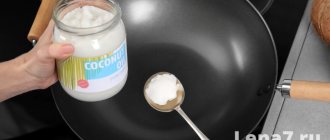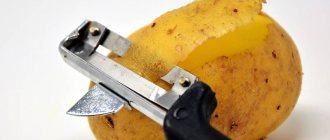Coconut milk is becoming increasingly popular these days. The scope of its application is wide.
In cooking, the product is used for making cocktails, desserts, smoothies, and puree soups; in cosmetology, skin and hair care products are made on its basis.
How to properly store this exotic drink? And if you didn’t use all the milk right away, where can you use it? We will tell you further how you can and cannot store coconut milk.
Rules and storage time
Coconut milk should not be confused with juice. Many people believe that milk is the liquid that formed inside the coconut as it ripened. This is incorrect, such a liquid is called juice, it is completely fat-free and consists of 95% water.
Milk is produced artificially - the pulp of the nut is squeezed out and mixed with water (approximate ratio: 60% coconut and 40% water).
You can make your own coconut milk. But now this product is no longer so exotic and is sold in any supermarket . To prevent its premature deterioration, it is imperative to monitor the expiration date and comply with certain storage conditions.
Shelf life of coconut
When talking about how to store coconut at home, you need to understand that the shelf life of any product directly depends on its storage conditions. For tropical “nuts”, humidity exceeding 70% and temperatures above 20 ºC are not allowed. In the refrigerator it will not spoil within 2-3 weeks. Moreover, its safety directly depends on the integrity of the peel. Damaged fruit should not be kept for more than 2-3 days, even in the refrigerator, otherwise there is a possibility of getting a spoiled and sour coconut.
Information about the expiration dates and storage conditions of any products can be found directly in the store. It must be printed on the product label. If there is no such label, the buyer has the right to report the violation to the regulatory authority.
If the nut has not yet been opened, there are no cracks or spots of rot on it, there is no sour smell coming from the peel, it can be kept in a cupboard or on a shelf in the pantry. The main thing is that it is dry and dark, the air temperature does not exceed 20 ºC, and the humidity ─ 70%.
General recommendations
Coconut milk is sold in tetra packs or cans.
The packaging indicates the production date and shelf life (usually from 24 to 36 months). Temperature conditions for storing unopened packaging: from +2° to +30° .
When buying a product in a store, choose one with a shorter shelf life. This ensures that it contains fewer preservatives and harmful additives. The ideal drink contains only water and concentrated coconut milk.
In the refrigerator after opening the package
If you open the jar and do not use it all at once, then the remaining contents should be poured into a non-metallic container and kept in the refrigerator . It is not recommended to leave a drink in a tin container!
It is advisable to pour the coconut milk from the Tetropack into a glass container and tightly close the lid. The shelf life of the drink in this form is no more than three days.
Many housewives make the mistake of storing milk in the refrigerator door. Remember that this is the warmest place. And the middle or upper compartment, where the temperature is about 6-8°, is considered ideal for storage.
It should also be taken into account that coconut milk easily absorbs foreign odors. Do not store it near strong-smelling foods (smoked sausages, Korean salads, fish). And don’t forget to tightly close the lid on the milk container. If you prepared the drink yourself at home, then you need to use it within 1-2 days.
In the freezer
It is in vain that some housewives consider freezing not the most successful way to store food. Such food is called “dead”, losing vitamins, beneficial microelements and taste. There are a number of products to which this does not apply in any way. And one of them is coconut milk.
So if you are not going to use the opened milk in the coming days, then you can safely freeze it and then defrost it without fear that the drink will lose its taste.
Basic rules for freezing coconut milk:
It is advisable to freeze the product in small containers. You can use a container or plastic jar, but do not fill it to the top as milk expands when frozen.- Defrosting should be done gradually - do not immediately leave the milk at room temperature, but after putting it in the freezer, keep it on the refrigerator shelf for 24 hours.
- Place a container with completely defrosted coconut milk in hot water for 5-10 minutes, mix the contents well and only then drink or use for cooking.
Coconut milk cannot be re-frozen. A frozen product must be used within 3-4 months.
Frozen coconut milk is great for making smoothies. In this case, it is best to freeze it using ice cube trays.
This is done as follows:
- Pour the drink into molds and place in the freezer.
- Wait until it freezes completely.
- Remove the milk cubes from the molds and place them in a container or plastic bag.
- Place in the freezer again.
This is a very convenient way! When you need to use milk, you defrost exactly as much as you need. Details are in this article.
How much in room conditions?
Store unopened containers of coconut milk at room temperature. But cold rooms (such as pantries, cellars, balconies), where the temperature can drop below +2°, are best avoided. Otherwise, flakes will form in the drink.
How and where to store coconut oil after opening?
One of the negative factors affecting the storage of coconut oil is air access.
If the required storage conditions are observed, the shelf life of the oil after opening the original packaging does not decrease.
The exception is cosmetic oil in ampoules, which after opening are recommended to be used within 12 hours.
If there are no signs of spoilage and the oil is stored according to established rules, then it can be used for several months even after the expiration date as a cosmetic product.
However, long-expired oil can still be useful; it can be used as a technical fluid, for example, as a furniture polish.
Coconut oil is a valuable product used in cosmetology and as a culinary additive.
The ideal environment for storing the product is a refrigerator shelf or door, or a closed cabinet, glass or factory container with a tight stopper.
But even if the conditions are met, it is recommended to adhere to the expiration dates established by the manufacturer.
In cosmetology, oil is used in ampoules; it is recommended to use it no more than 12 hours after opening.
Features of use
If you bought coconut milk and, when you get home, want to drink it right away, then you just need to shake it well before drinking . This must be done, because during storage the product separates, that is, water appears at the bottom, and a thick white mass collects at the top. This does not affect the taste in any way.
A container of milk that has been stored in the refrigerator must first be placed in hot water for 5-10 minutes, and then shaken and drunk. Before drinking milk that has been stored in the refrigerator in an open container, you must not only hold it in hot water for 5-10 minutes, but also stir it periodically.
Do not forget that the consumption rate of coconut milk is far from the same as that of cow's milk. For an adult, 100 ml every 3-4 days is enough, for children over 3 years old - no more than 50 ml.
Shelf life of coconut
If you store coconut on a shelf in the refrigerator, the shelf life of a whole coconut increases to 30 days. Some believe that up to 2.5 months. You can store a closed coconut in a kitchen cabinet at room temperature, but no more than a week. With longer storage, the fruit begins to dry out and deteriorate, losing its taste and beneficial properties.
An opened coconut doesn't last long. Even if stored in the refrigerator, it will stay fresh for at most 2 days. Coconut milk, poured into a glass container and tightly closed with a lid, can be stored in the refrigerator for up to 7 days.
This can be done by freezing both the coconut milk and the pulp. Before pouring the milk into ice molds, you need to carefully remove the fat that has formed from the surface, otherwise it will not harden and will then flake off. The shelf life of frozen coconut milk is up to 2 months. It is best to grind the pulp in a blender. Place the resulting coconut crumbs in a vacuum bag and put them in the freezer. It should be used immediately after defrosting and is best used in cooking. Frozen coconut can be stored for up to 1.5 months.
What do the resulting flakes indicate?
It happens that when you open a can of coconut drink, you can find flakes formed in it .
This is not yet a reason to think that it has deteriorated. It was simply stored or transported at the wrong temperature (in cold conditions). The buyer has every right to return such product to the point of sale.
The flakes do not have any effect on the taste of the prepared dishes. It is quite acceptable to use such milk for confectionery and baked goods, soups and cereals, cocktails and smoothies. But it is not recommended to add it to granola or coffee, as the flakes will spoil the taste.
Is it possible to increase the time frame?
If milk is stored in the refrigerator for a long time after opening the can, be sure to check it periodically for signs of spoilage:
- stale taste, reminiscent of tin (this is why it is not recommended to store the product in an open tin container, as coconut milk begins to gradually absorb the smell of the can);
- the surface of the milk is covered with pink mold;
- the product has acquired a grayish color.
To prevent spoilage of an open drink, it is better to immediately pour it into small containers and freeze it. This way you can extend the shelf life up to four months.
Storing Coconut Oil
Coconut oil should be stored in the refrigerator after opening the jar. It is important to comply with the following standards:
- temperature - +5°C -+8°C for cold-pressed and unrefined product. Refined can withstand storage at +25°C;
- air humidity should be at 65%;
- the storage container should be selected from opaque glass or plastic;
- The lid should fit snugly against the edges of the jar.
Neglect of storage rules and the influence of temperatures below +5°C have a detrimental effect on the quality of the oil.
Signs of a spoiled product:
- the appearance of a bitter taste and unpleasant odor;
- oil with a solid structure loses its white color, and liquid oil ceases to be transparent;
- the product separates and lumps and grains form in it;
- the color of the oil becomes yellowish;
- the surface of the product becomes covered with mold spots.
Coconut oil that shows obvious signs of spoilage should not be stored further. This product must be disposed of immediately.
What to do with the product if it is expired?
Do not rush to throw away coconut milk that has expired:
- Use it to cleanse your acne.
- Apply as a mask to strengthen weakened hair.
- To add shine to your curls, combine this milk with coconut oil in equal proportions, add egg yolk and apply the resulting mixture to your hair. After 30 minutes, rinse with warm water.
- Regularly wipe your skin with coconut milk, this can give it elasticity and slow down the aging process.
- If your hair is dry, then combine coconut milk with honey in a 2:1 ratio, and rub the resulting mixture into the skin and distribute along the entire length of the strands. Leave for 1 hour under a warm hood. Repeat the procedure once a week.
Useful tips
Tips to help when storing the product:
Coconut milk is not a cheap product.
If such a luxury is not permissible, then try making a delicious drink yourself at home. The nut pulp must be carefully cut off, crushed in a blender and poured with warm water (400 ml per 1 coconut). Let it brew a little, squeeze it out with gauze and pour the resulting drink into a container.- Coconut milk cannot be called low-calorie, but it is absorbed by the body better and faster, so it does not have time to be deposited as fat. In addition, this product contains no cholesterol. So for people losing weight, its use is quite acceptable.
- Due to the fat content of coconut drink, it is recommended to dilute it with water. For example, to cook porridge with it, take 1 part milk and 2 more parts water.
- When choosing a coconut drink in the store, give preference to producers from tropical countries. Powdered milk is produced in Russia and Europe.
- Coconut milk should not be boiled, otherwise it will separate into flakes and water.
- You can replace coconut milk in recipes with cow's product with the addition of coconut flakes.
How to store coconut at home
Fresh, unopened coconut can be stored for quite a long time. In this case, one condition must be observed - do not keep it next to other fruits.
Do you use expired food for cooking at home?
Yes, the main thing is to process it if it is meat or expired kefir for pancakes.
27.12%
No, it is very dangerous and not useful.
37.57%
If the products have fungus or mold, then we throw them away; if they are a couple of days past their expiration date, we use them for food, even without heat or other treatment.
35.31%
Voted: 1637
On the shelves of our stores, the beloved coconuts have long been side by side with the usual nuts and fruits. In addition to their pleasant taste, they contain folic acid, which is so necessary for all of us, which is responsible for cell growth throughout the body, their renewal and restoration. Women especially need it during pregnancy. Coconut contains a lot of vitamin C, proteins, fats and carbohydrates. In order to maintain all the beneficial properties of this product, it is very important to store it correctly at home.











